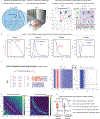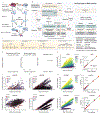Mapping transcriptomic vector fields of single cells
- PMID: 35108499
- PMCID: PMC9332140
- DOI: 10.1016/j.cell.2021.12.045
Mapping transcriptomic vector fields of single cells
Abstract
Single-cell (sc)RNA-seq, together with RNA velocity and metabolic labeling, reveals cellular states and transitions at unprecedented resolution. Fully exploiting these data, however, requires kinetic models capable of unveiling governing regulatory functions. Here, we introduce an analytical framework dynamo (https://github.com/aristoteleo/dynamo-release), which infers absolute RNA velocity, reconstructs continuous vector fields that predict cell fates, employs differential geometry to extract underlying regulations, and ultimately predicts optimal reprogramming paths and perturbation outcomes. We highlight dynamo's power to overcome fundamental limitations of conventional splicing-based RNA velocity analyses to enable accurate velocity estimations on a metabolically labeled human hematopoiesis scRNA-seq dataset. Furthermore, differential geometry analyses reveal mechanisms driving early megakaryocyte appearance and elucidate asymmetrical regulation within the PU.1-GATA1 circuit. Leveraging the least-action-path method, dynamo accurately predicts drivers of numerous hematopoietic transitions. Finally, in silico perturbations predict cell-fate diversions induced by gene perturbations. Dynamo, thus, represents an important step in advancing quantitative and predictive theories of cell-state transitions.
Keywords: RNA Jacobian; RNA metabolic labeling; cell-fate transitions; differential geometry analysis; dynamical systems theory; dynamo; hematopoiesis; in silico perturbation; least action path; vector field reconstruction.
Copyright © 2022 The Authors. Published by Elsevier Inc. All rights reserved.
Conflict of interest statement
Declaration of interests E.S.L. is currently on leave from MIT and Harvard to serve as the Director of the White House Office of Science and Technology Policy. J.S.W. declares outside interest in 5 AM Venture, Amgen, Chroma Medicine, KSQ Therapeutics, Maze Therapeutics, Tenaya Therapeutics, Tessera Therapeutics, and Third Rock Ventures. V.G.S. serves as an advisor to and/or has equity in Novartis, Forma, Cellarity, Ensoma, and Branch Biosciences. All interests mentioned earlier are unrelated to this work.
Figures









References
Publication types
MeSH terms
Substances
Grants and funding
LinkOut - more resources
Full Text Sources
Other Literature Sources

